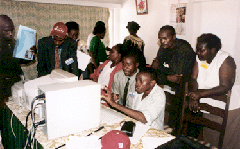Natasha Martin Assists Community-based health care
workers develop AIDS prevention programs in Kenya.
|
 Gary Selnow had been providing Internet-linked computer Centers to promote democracy in the Balkans. Both are
Coastside residents and neither knew about the work of the other (the Coastside refers to the Pacific coast area
south of San Francisco).
Gary Selnow had been providing Internet-linked computer Centers to promote democracy in the Balkans. Both are
Coastside residents and neither knew about the work of the other (the Coastside refers to the Pacific coast area
south of San Francisco).
One day last year, Natasha read about Gary's work in a Half Moon Bay Review article and also heard his colleague Bess Klumb
speak at the local Rotary Club about the use of computers among orphans in the Balkans. She asked if he thought computers
might contribute to AIDS prevention programs in Africa, especially among the youth orphaned by HIV/AIDS. He figured they
could, so they talked about it, and that conversation started a chain of events that is leading now to a network of
Community-based Health Information Centers in Africa.
Twenty-five Community Health Information Centers for Africa: A Coastside Story
In June 2001 we returned from an experiment in Mombasa, Kenya. Our goal was to determine if we could teach a group of young
people -- who never before had touched a computer -- how to run basic computer programs and how to access the Internet.
We knew we could teach them, but the challenge was: could we teach them to train other people how to use computers -- and
do it all in four days? If we could do this, we could quickly prepare a cadre of skilled computer operators in Kenya to
provide training at the local level. The local connection is key to the Community Health Information Centers that we'll
describe later. First, we need to describe the experimental training sessions.
Training Experiment
Natasha, working with Global Strategies for HIV Prevention, organized a workshop in Mombasa for more than 200 community
health-care workers from several countries in East Africa. The focus of those sessions was to prepare practitioners for
the huge challenges of dealing with AIDS at the local level.
While the conference was underway, Gary, who works with World Internet Resources for Education and Development (WiRED),
offered computer training for seven college-age men and women who were techno-novices. We had to take these young people
from zero to 60 in four days -- from not understanding the movement of a mouse, to teaching other people how to run a computer.
The "kids" put in ten-hour days from Monday to Thursday night. We started with PowerPoint-aided lectures then moved to hands-on
training that involved word processing, graphics development, Web searches and e-mail correspondence. All the while, we prepared
the students to teach these skills to other people. We discussed how to explain technical matters, how to hold a student's
interest, how to inspire creativity. Sometimes we conscripted reluctant by-standers into the role of student and practiced on
them. Practice sessions proved to be a huge help in teaching the trainers to train.
At the end of four days, the seven students had accomplished something remarkable which they demonstrated Friday morning at a
plenary session of the conference. After each of them made a short speech, they all moved to demonstration tables where they
taught basic computer operations to the health care workers, most of whom were themselves novices. Natasha scheduled two hours
for the training demonstration, but the demand was so great, it was seven hours before the thrilled, but exhausted, young
trainers shut down the computers.
Health Information Centers
Training is the final element in a program that will provide health-related information in 25 Kenyan communities and ultimately
in a much broader region across Africa. Through the combined efforts of Global Strategies and WiRED, each of the selected
communities will receive small computer networks that will house a substantial library of medical information. Each center
will also provide age-specific, AIDS prevention tutorials that will help prepare young people to avoid the disease. The
Centers, additionally, will provide practical information about prenatal and child care, nutritional topics and other
region-specific, health concerns such as malaria and tuberculosis.
Further, most Community Centers will offer health-care professionals access to the Internet and e-mail. In remote regions,
where Internet service is not available, the centers will access e-mail using special short-wave radio equipment. Communication
among the centers and with outside medical and training facilities is essential in a coordinated AIDS education program.
For this training, we hope to continue to recruit youth from among the more than 600,000 Kenyans orphaned by HIV/AIDS in a
country where 70 percent of the population is under 20 years of age. They will become community educators and will also be
able to use their skills for economic development. "Youth are future leaders; if they are involved in community betterment,
we are shaping them into responsible leaders of the future" said Anne Owiti on the plight of HIV/AIDS orphans in Kenya.
The Mombasa experiment was funded by the Firelight Foundation, a Santa Cruz based foundation focused on improving the lives
of orphans of HIV/AIDS in sub Saharan Africa. The second phase, which is funded by National Institutes of Health Office of
AIDS Research, will include the installment of Community Health Information Centers in five Kenyan communities. By January
2002, WiRED will be training medical staff that are associated with the following Kenyan organizations:
- COBA Development Agency in Kilifi
- Pandiperi AIDS Control Program in Kisumu
- MAA AIDS Awareness Program in Kajiado
- Kenya AIDS NGOs Consortium (KANCO) in Nairobi
- Rural Education and Economic Enhancement program (REEP) in Butulato
|
|

